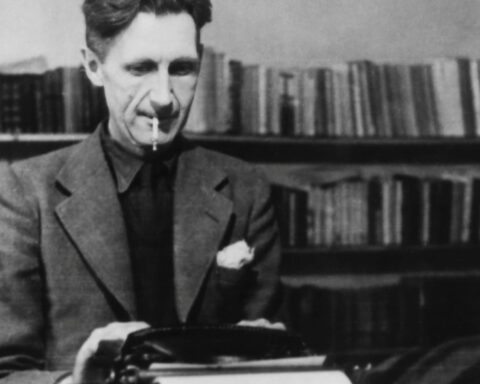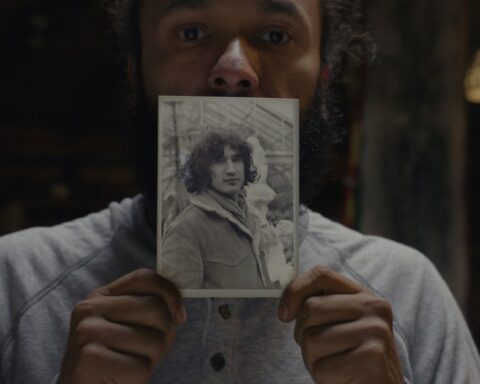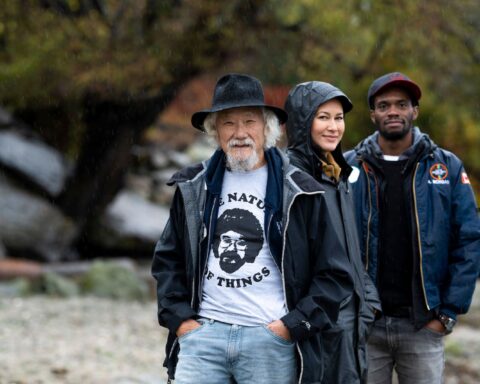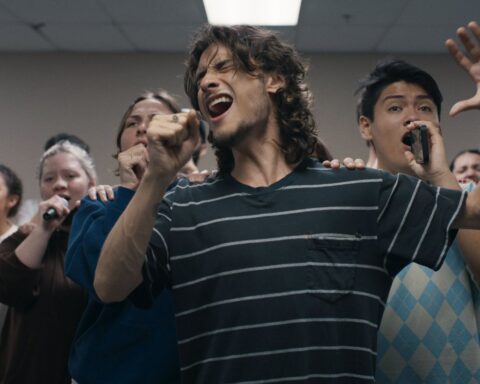July 13, 2014, Rio de Janeiro.
The Argentine and German football squads are preparing to face off in the FIFA World Cup finals. Mostly international tourists will be attending today’s match while the majority of Brazilians will watch from television screens outside. But some Brazilians won’t be watching the game at all; instead they’re taking to the streets to exercise their constitutionally guaranteed right to protest. It is not mere opportunism that brings them to the streets, seeking to capitalise on all the attention garnered by the Cup. Their grievances are very much tied to the international spectacle and the social legacy it will leave in this country. When the circus leaves town, it is Brazilians who will bear the brunt of the hangover, sifting through the trash to recover all the discarded beer cans after the party.
Donning a Canadian military gas mask and bright yellow Activist helmet from Mountain Equipment Co-op, I am in the eye of the storm, the Saens Peña square, one mile from the iconic Maracanã Stadium and ground zero for today’s protest. I am in Rio continuing production on my first feature-length documentary about forced evictions in advance of the 2014 World Cup and 2016 Olympics.
Police have quarantined activists and media alike, using the same kettling tactic we saw police using in Toronto during the G20, when I was in the streets shooting my first short documentary, Demur. No one is permitted to enter the square and no one may leave. The memory card in my camera fills up and I press myself against a wall to change it. A line of military police are running by and one swings his baton my way, an indication to all successive police in line that I must be one of the terrorists they have been looking for and I am soon taking blows from all sides. I drop to the floor, batons continuing to crash down on me. One of the officers rips off the GoPro camera affixed to my helmet, and another swoops in for the final blow, a swift boot to the chops. As I am whisked away to the hospital in an ambulance, I cannot help but ask myself: How on earth did I end up here?
The answer to that is a long story.
***
It is 2010, and I’m returning to Brazil, a country I fell in love with after living in the cities of Recife and Belo Horizonte between 2006 and 2008. I am in Rio to co-present a film I co-directed with Canadian documentary filmmaker Tom Radford, Cities Crossing Borders. Rio is hosting the 5th UN Habitat World Urban Forum. We have been invited to present our feature-length film, and show a 20-minute version at the opening ceremonies on nine large screens before 8,000 guests gathered from around the globe, including Brazil’s President Lula and several other heads of state. We have a captive audience and are pleased for the opportunity to set the tone for the week’s prestigious event with our hard-hitting film about the crises facing megacities, the supposed focus of the event.
As the room fills up and the film’s opening sequence rolls, the cheery samba music that has been serenading the arrival of delegates all morning never fades, and our film plays start-to-finish as a silent slideshow. This was no technical glitch: it is evident that the “tone” of our piece was not in keeping with the festive atmosphere event organisers were trying to construct in a bombastic fashion. Our silenced film was a mere prelude to the extensive song-and-dance that would follow, a full-on “Carnaval” procession mounted to welcome all the international delegates to the so-called “marvellous city” of Rio. This was my first experience with censorship in Brazil but it would not be my last.
Angry and disappointed, we exited the Lula event and walked across the street to the parallel gathering being organised by Brazilian civil society, the World Social Forum. It was a revelation to be there. While not much of a sports fan, I must admit my affinity for the World Cup and Olympics, perhaps duped by all the rhetoric of FIFA’s (Fédération Internationale de Football Association) “beautiful game” and the values of the Olympic charter. My naïve appreciation for these events was quickly undermined by everything I heard at the forum. Despite the stereotype that all Brazilians are crazy about football, the ones I met were deeply concerned about the potential social impacts of these events, particularly in Rio, where the two mega-spectacles would be hosted back to back in 2014 and 2016.
The Brazilians told me that when FIFA and the IOC (International Olympic Committee) come to town, a “state of exception” is imposed: a legal framework that temporarily suspends the rule of law and strangles civil liberties such as the right to free movement and protest. Since 2010, thousands of families have been forcefully displaced, despite unambiguous international laws prohibiting such displacement. The “state of exception” is justified by the expediency needed to prepare for the World Cup and the Olympics, time-sensitive events that cannot be jeopardized by the potential delays of due legal process.
I returned to Canada tremendously concerned for the fate of Brazil. I started researching past Olympics and World Cups and what I discovered was appalling. I learned about the role hosting the 2004 Olympics played in precipitating Greece’s successive debt crises, the thousands of poor displaced and relocated to in Canada, where the epic 1976 games, bid at a total price of $120 million, ended up costing $1.5 billion, leaving Montreal indebted for 30 years. (All this after the Montreal mayor Jean Drapeau famously declared, “The Olympics can no more have a deficit than a man can have a baby.”)
Wide-eyed idealism is not uncommon in the mega-events’ bid processes. Since 1976, the average cost overrun for the Olympics has exceeded 200 per cent. As event critic Helen Lenskyj so aptly summarizes: “These projects, massive in their scope and scale, cost many billions of public dollars and leave behind ambiguous legacies. Nearly every global mega-event has resulted in financial losses for the host, temporary cessation of democratic process, the production of militarized and exclusionary spaces, residential displacement and environmental degradation.”
Having lived in Brazil twice before and knowing what I did of the socio-political context in that country—a new democracy emerging from a totalitarian dictatorship with high levels of corruption in both the private and public sphere—I realised that the country was heading into a crisis. But I also knew that the pending social catastrophe was hardly a fait accompli; on the contrary, Brazilian civil society boasted some of the world’s most effective political organizers.
It is no coincidence the World Social Forum was born in Brazil, in Porto Alegre in 2001 under the guiding principle that “another world is possible.” Social movements from all corners of the globe gathered for the first time at what would become an annual international gathering. There were no leaders nor unifying ideology; in their place was vehement disagreement as to what that “possible other world” might look like. It was pure democracy in all of its messiness. Brazil is also home to the Landless Workers’ Movement (MST), one of the world’s most successful and widely studied social movements, and to Paulo Freire, whose Pedagogy of the Oppressed asserted the democratic power of the world’s marginalized classes.
In Rio, many of Brazil’s marginalized people live in the favelas. Historically, the favelas emerged in marginal unliveable hillsides, public lands that were settled by rural migrants flooding to the city to provide the labour for Brazil’s industrial boom throughout the 20th century. Brazilian usucapio laws formalized squatters’ rights and allowed acquisition of land through unchallenged possession for a specified number of years (usually 10). After the decline of the dictatorship, which had lasted from the 1960s to the mid ’80s, in acknowledgement of the tremendous sacrifice made by the labouring class, favela residents’ right to housing was strengthened even further. A constitutional clause was passed that guaranteed land ownership as a fundamental right, and required that all land serve a social function. It’s this very same clause utilized by the MST that has been used to successfully reclaim lands from Brazil’s plutocracy. The clause is perhaps the world’s most progressive example of formal squatters’ rights guaranteed by a nation’s constitution.
Since the dictatorship lost power in the mid ’80s, populist elements in Brazilian civil society had been readying themselves for a showdown with the neo-liberals and oligarchies that ruled the nation. Under Lula, who started his political career with radical rhetoric but quickly became “establishment,” Brazil’s economy was booming with global capital flooding into the country, The push to cleanse Rio predated the World Cup, with the growing bourgeoisie desiring to take over the favelas, places for the poor, which were suddenly fancied by the wealthy as real estate speculation in surrounding neighbourhoods boomed.
With the mega-spectacles of the World Cup and the Olympics providing the opportunity that the opportunists had been waiting for, land was being seized and civil rights oppressed. The battleground was set for a series of confrontations. I knew that I needed to tell this story.
***
In 2010, I was an aspiring filmmaker with little experience and no contacts in Rio, but I spoke Portuguese. I packed my camera, jumped on a flight and started talking to people. It did not take me long to make connections with Rio’s social movements. I was an outsider but was warmly received. While I’m no fan of reductionist stereotypes, it is true that Brazil is a very receptive culture, a fact exploited by both FIFA and the IOC.
On this first trip, I awoke one morning to a message that a forced eviction was under way in the west part of Rio in the community of Vila Taboinha. I hightailed it to the location where the community entrance was barricaded: men, women and children were refusing to allow the passage of the bulldozers. It was not long before the state riot police were called in. What happened next has become a tired story: tear gas, rubber bullets, the whole force of the Brazilian state unfurled upon the men, women and children who courageously stood in defence of their community. Despite the brute force, the police were outnumbered and the community defiant, and as the sun set, the police were forced to retreat. It was a small victory, an early coup for the “Davids” of the favelas against the Goliath that is the Brazilian state, with global capital in tow.
Three days later, with most of the community away at work, the police returned, this time with neither the same fierce community resistance nor the media presence of days before. The bulldozers started toppling homes. Working with an activist friend, I started shooting the bulldozer emerging from the rubble where buildings had stood a half-hour earlier.
We were accosted immediately by the police chief, who screamed in my face: “This is not for the world to see!” I begged to differ. The police started antagonizing us and we were quickly surrounded by the community, who rose to our defence, several of them filming the altercation with their cell phones, the new instrument of accountability. The chief was bluffing and we knew it. The intimidation was quickly reversed and the police forced to withdraw. We were quickly ushered away by members of the community who accompanied us from one safe hiding place to another, awaiting the departure of the police. It was on that day in Vila Taboinha that the documentary project, which is still occupying my life, was born. The community was confronting what seemed like a helpless situation and clearly saw my camera as a glimmer of hope amidst an utterly desperate situation. And I was completely out of my comfort zone, confronting aggressive police threats, totally reliant on the community for my own safety. The incident clearly demonstrated the emerging power of citizen journalism, the new accountability being created by the infallible witnesses that are video and cell-phone cameras.
It also made me realise the necessity of embracing a participatory framework to produce the kind of film I want to make, because the State was clearly going to try and carry out its dirty work away from the peering lens of the media. They never considered that the communities they are seeking to evict may well become media-makers themselves, and I had a feeling this could well be the communities’ best defence.
Years earlier, I had organized a series of participatory photography workshops in a number of Brazilian favelas, utilizing a methodology that would later be made famous by the Academy Award–winning documentary Born into Brothels, putting creative tools in the hands of the socially marginalised to tell their own stories. Combining Paulo Freire’s ideas as they apply to media-making with lessons from the NFB’s Challenge for Change programme, our project ethos was born. I began bringing equipment down to a growing network of activists and community residents, most of whom had no experience with video but were keen, and quickly started filming.
The discourse around community video has been constructed around the high ideals of empowerment, participation and democratic control. It has attracted criticism as hyperbole since such ideals are incredibly difficult to achieve in practice. There is a risk that, under the guise of empowerment, the methodology is in fact imperialistic, indenturing participants to a project in which they have no power over the final films.
Such a state of indenture would be antithetical to the very ethos of participatory media. I work with Brazilians and there are no strings attached. Their own media activism shall always come first, the documentary second, if they so choose to participate. I don’t own any of their footage—they do. Of course, such an open arrangement cultivates a mutual sense of loyalty. Most participants are very eager to contribute to the documentary, so it is not just a matter of ethics, but also the most strategic approach in terms of securing participation. It’s a win-win situation.
One of my earliest collaborators, Patrick Granja, is a journalist writing for the bi-weekly Marxist newspaper based out of Rio: A Nova Democracia (The New Democracy). Since equipping him with his first camera, he has published 300-plus videos on YouTube, garnering over 24,000 subscribers and 7.2 million channel views. In Patrick’s case, our ethos of participant agency has meant building a career as an independent media activist, making a living selling the exclusive footage to international media. And so a lot of our footage is already in the public domain, on YouTube and appearing in news reports and documentaries all over the world on the BBC, VICE News, Al-Jazeera, and many other major media outlets. There have been many horror stories in Rio that would have never seen the light of the media’s glare if Patrick hadn’t started showing up every time a poor favela dweller was murdered by the police or a community was being evicted from their homes. He publishes all of his stories on YouTube, sometimes journalistic in presentation and other times accompanied by Pat’s voice-of-God narration. It has been very interesting to watch Pat’s developing aesthetic as he has evolved from simple montages combining witness testimonies and narration, to more sophisticated evidentiary methods i.e., long takes, combining synced split-screen images from our multiple cameras.
When Pat’s cell phone rings, my heart always skips a beat. I remember one afternoon in 2012, Pat had a hunch that something serious was going to go down that evening in Complexo de Alemão, an area of 11 favelas in Rio’s North Zone, and he asked me to join him on his mission. Visitors to Rio can visit Complexo de Alemão, riding a quarter-billion-dollar gondola (identical to those used at ski resorts) to the heart of the community and back without ever having to disembark. It would not be out of place for there to be a sign posted “Visitors should remember to please keep their hands inside at all times and not feed any of the poor favelados below.”
The community was already under military rule in 2012, in a state of transition to the installation of permanent “pacification” police (UPP). On recent nights, some of the military men had been throwing their weight around and antagonizing residents, arbitrarily shutting parties down and even entering homes and helping themselves to residents’ food. Hostilities were growing between residents and the military occupiers. We headed up the hill before sunset and sure enough, as night fell, the commotion began immediately and the community descended into riots. Young kids scurried through the alleys with shirts over their faces and rocks in their hands; the fluorescent pink lights of tracer bullets filled the night sky as the military forces were firing live rounds. We were right in the middle of it all for hours and I was terrified but kept on shooting footage. Two residents were killed that night.
When we left in the early hours of the morning, we passed through several military blockades. The community was in lockdown. We passed the media scrum at the base of the community, several kilometres from the eye of the storm with all the journalists wearing helmets and bullet-proof vests.
***
The next time I would return to Alemão was in late 2012, this time to investigate a triple homicide by the newly minted “pacification” police (UPP). “Pacification” is one of those fabulous examples of overt doublespeak not dissimilar from the “freedom” the U.S. military have been bestowing the world over. Initially, “pacification” brought much hope to communities that had long been suffering from the violence associated with criminal gangs and militias. Those hopes were quickly dashed by the egregious abuses of a new gun-toting gang perpetrating summary executions and disappearances, this time with official state sanction.
We were called to Alemão by human rights investigator Márcia Honorato, who was investigating the case of two young boys that had been shot down by a member of the UPP, one of the youth killed point blank, the second wounded but initially still alive. Residents reported that a second UPP officer pleaded with the shooter that they should bring the wounded youth to the police station. The aggressive officer retorted to the other that he better shut his mouth or he was going to end up like these kids, with a bullet in his head. Hours later, both the protesting officer and the surviving boy were found murdered. After her investigation, Honorato concluded that this was a triple homicide. The sequence of events comprises the most horrific scene about artists in Rio who are protesting against such cases of egregious violence by the UPP in the so-called pacified favelas.
I travelled back and forth from Canada to Rio eight times over the course of four years (from 2010 to 2014), for a total of 32 weeks of production, bringing more and more video gear and growing our collaborative network of video activists on the ground. In June of 2013, on the eve of the FIFA Confederations Cup (the rehearsal for the following summer’s spectacle World Cup event), Brazilians took to the streets en masse in what became known as the Brazilian Spring. The initial impetus was a 20 centavo (10 cents) hike in transit fares in São Paulo, which might seem inconsequential to most, but to the working poor whose commute often consists of many such buses in a non-integrated transit system, the fare increase was a tipping point that threatened their already precarious economic survival.
It was not the fare hikes but the heavy-handed response by the state that sent Brazilians to the streets en masse, and within days the whole country had erupted in the largest civil uprising in Brazilian history since the 1992 protests calling for the impeachment of President Fernando Collor de Mello. The government quickly reneged on the transit fare increase but it was too late. Brazilians had had a taste of their collective power and their rallying cry quickly became “It’s about a lot more than 20 centavos,” and much of the discontent was projected on the spectacle events. The grievances being expressed in the streets were multi-fold: thousands of families forcefully evicted from their homes (often brutally, by riot police firing tear gas and rubber bullets); overspending on the football stadiums and other event-related infrastructure, while basic public services such as health care, education and basic sanitation were pitifully underfunded; and the militarization of the favelas in Rio, through the “pacification” program.
One of the largest mobilizations took place for the Confederations Cup finals in Rio at the iconic Maracanã stadium. As the Brazilian squad vanquished Spain 3-0 inside, we were confronted by a scale of repression we had never before seen in the streets outside, dodging rubber bullets and choking on military-grade tear gas. The fact that Brazil’s elite football squad was kicking a ball around for the entertainment of the economic elite inside the Maracanã while the military surrounded the stadium to keep the Brazilian populace at bay was the ultimate metaphor for the increasing social exclusion spawned by these mega-events. Since its inauguration for the World Cup in 1950, Maracanã has been a landmark in Brazil, a temple of not just sport and home to much of Pele’s illustrious career, but also the location of some of Brazil’s most important political rallies. Hosting as many as 200,000 revellers in its heyday, it was the largest stadium on the planet.
Most importantly, Maracanã was thoroughly Brazilian, its very architecture reflecting its accessibility as a popular space. The “best seats in the house” were not seats at all; they were the geral section at ground level circumnavigating the field, where the energy was raucous and the chanting deafening. The geral was where the culture of futebol thrived. The geral was not just closest to the action, but the tickets were just one Brazilian real (50 cents), so accessible even to the poorest citizens, who would often panhandle outside the gates to gain access to the cultural experience inside the most iconic temple of football—Maracanã.
The pressure to reform Maracanã began in the lead-up to the 2007 Pan Am Games, Rio’s first big mega-sporting event, a precursor to the city’s ambitious event bids to FIFA and the IOC. The stadium was closed for renovations in the lead-up to Pan Am, the geral section eliminated entirely and the first luxury boxes installed. The stadium would close again prior to the World Cup—the capacity was reduced to a mere 78,000 and even more luxury boxes were installed, as per FIFA’s stringent stipulations. The Maracanã had been turned into a world-class stadium to host a world-class event, Brazilians be damned. The transformation of Maracanã has reflected the broader transformations across the urban landscape, where accelerated gentrification is occurring en masse.
It is true that the World Cup and the Olympics bring extraordinary benefits, but they create profits for an international elite—the Brazilian construction industry, FIFA and the event sponsors—while the costs are socialized and borne by the Brazilian populace. FIFA paid no taxes in Brazil and committed one of the greatest heists in Brazilian history upon its citizenry.
***
July 13, 2014. The FIFA World Cup Finals will be played at Maracanã today. Significantly, it is not the Brazilian squad but their arch rivals Argentina who will be facing off against Germany in the final, after the Brazilian team was annihilated 7-1 in the semi-final in what was the most embarrassing loss in the history of the World Cup. Nothing could be more apparent than FIFA’s “state of exception” today. Rio is seeing one of the largest mobilizations of military and police forces since the end of the dictatorship. It isn’t Brazilian citizens the police are here to protect. It’s clear that they are protecting FIFA and the associated global capital interests. The police have been sent to the streets to brutally repress and censor any dissidents who might spoil the party.
And so it was in this context that I was savagely beaten by a group of military police. There was nothing particularly special about my case. I had witnessed many such unprovoked attacks by the police at protests before; however, on this occasion, it was a privileged “gringo” who had been attacked, and the story made international headlines. While the police have been beating, torturing and disappearing poor “favelados” for a long time, they had overstepped their duty and swung their batons at me, one of the international visitors they were tasked much international media attention is emblematic of precisely the inequalities Brazilians were protesting against in the streets that day: the transformation of the urban landscape in Rio and throughout Brazil to serve people like me, international tourists and capital, at the expense of the people who actually live here.
While I have no personal footage recording the moment of the attack as my memory card had just filled up and my GoPro stolen, the incident was partially captured by my team, who quickly gathered all of the citizen footage. They performed a frame-by-frame forensic analysis, identifying two of the aggressors and breaking the story online, publishing their profiles in close-up photos captured at earlier moments in the day. The offending military police were arrested within hours of breaking the story and have since been removed from active duty while they await trial. The arrests were truly extraordinary given the culture of absolute impunity amidst Brazilian police, and was surely a public relations move prompted by this major embarrassment coinciding with the World Cup finals. This marked an important moment: my own beating filmed by my collaborators turning their cameras back on me, citizen security provided by the citizens themselves. While it was a small victory for justice, for Brazilians, the incident only adds insult to injury. When a foreigner suffers a relatively minor attack, there is accountability, while summary executions and disappearances at the hands of the police continue on a regular basis with complete impunity.
As most of the world watched the World Cup finals from the comfort of their homes, bars and restaurants in cities and towns across the globe, we should not forget the financial and social costs of creating this spectacle. Brazilians will be coping with the legacy of this event for years to come. While it’s easy to dismiss my experience as an unfortunate incident perpetrated by a handful of “bad apples,” we should take pause and consider the systemic context wherein the police are themselves victims of Brazil’s oppressive political system under global capitalism. Most police are themselves favela dwellers who are poorly paid and trained. They are (in most cases) pursuing a career in policing due to lack of other opportunities, much like African-Americans in the United States, who are represented twice as much in the military as they are in the U.S. population. This is not to dismiss the egregious violence perpetrated by a handful of the police, but amongst any mass harvest (the “thousands of new jobs created by the World Cup”), there are bound to be more than a few bad apples.
The police that were sent to the streets in Brazil for the World Cup and will be again in 2016 for the Olympics are not serving Brazilians. They are serving FIFA and the IOC, serving you, and protecting the status quo from the inevitable resentment that is going to boil up in host countries when the circus comes to town and no one bothers to consult or invite the people hosting the party. The problems run much deeper than the actions of a few bad apples: they are systemic and arise from the inherent dynamics of global capitalism. Events like the FIFA World Cup and the Olympic Games exemplify these dynamics. They are multi-billion-dollar commercial bonanzas that actively disenfranchise the majority to the benefit of the few. So much for the notion of fair play! As consumers of these global spectacles, we are all implicated in the story. In 2015, I intend to be back in Brazil documenting the next chapter of this tragic and infuriating narrative.











